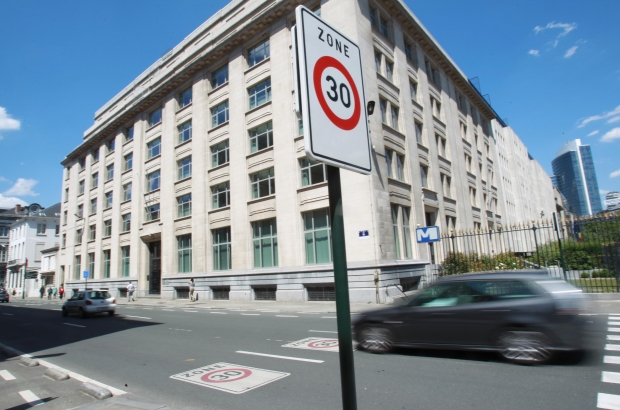- Daily & Weekly newsletters
- Buy & download The Bulletin
- Comment on our articles
A car-free Brussels? Not quite, but city has big plans for curbing traffic in centre
The City of Brussels is planning to significantly reduce auto traffic in its centre by using a variety of measures to reroute traffic, including one-way streets and traffic circles, beginning on 16 August.
The new circulation plan will see the Pentagon become a largely car-free area, which aims to provide more space for pedestrians, cyclists, public transit and micro-mobility means like scooters, according to a press release unveiling details of the plan.
“The circulation scheme will have a positive impact on both traffic safety and the accessibility of the Pentagon,” explained mobility alderman Bart Dhondt.
“Thousands of cars drive each day through the residential areas on their way to a place outside the city centre. They cross streets where children walk to school, young people cycle to the sports club, parents drop their children off at the day nursery, visitors shop, the elderly walk to a residential care centre or hospital. This transit makes our streets unsafe. It creates stress, traffic jams and air pollution.”
The circulation plan hopes to prioritise public space for people living in Brussels, rather than those just driving through. “We want to give the city back to the people who want to be here,” Dhondt said.
More accessible, healthier and safer
Brussels is one of Europe’s most polluted capitals, and a great deal of the pollution comes from the high amount of motor traffic in the city. This results in poor health outcomes for residents, hundreds of premature deaths each year as well as economic losses.
The new traffic plan hopes to make the heart of the city more easily accessible, healthier and safer by getting rid of as much vehicle traffic as possible, creating a more pleasant and attractive environment for those who live, work, shop or visit the city centre.
Proponents point out the success of low-traffic city centres both here in Belgium and in other European countries, including Paris, Copenhagen, Rennes, Nantes, Montpellier, Ghent and Marseille.
Brussels, too, will “build a city on a human scale,” said mayor Philippe Close.
Alternate means of transport
Close said many of the city centre’s residents werere already accustomed to a car-free lifestyle: only 30% of households in the Pentagon own a car.
“These figures show that the Brusselaars are ready to make more conscious mobility choices,” Close said.
“We recommend the STOP principle, which creates a hierarchy for means of transport: priority to pedestrians, to bicycles, to public transport and to cars for the people who need them. For this to work, we need to give our citizens all the tools to sustain such behaviour, and encourage them by adapting urban/urban infrastructure to their needs.”
Changes to intersections and high-accident zones
The new traffic plan targets 12 high-accident zones, improving safety at multiple intersections. In some cases, new safety measures have already been implemented, such as at the intersection of Rue Van Artevelde and Rue Pletinckx (Pletinckx-Van Artevelde and Dansaert-Van Artevelde) in the Bloemenhof neighbourhood.
Visitors arriving in the city centre by car will be directed to the nearest public car park.
The idea is that, together with the new parking regulations, this will result in far less “searching” traffic (people driving around looking for street parking), which in turn will lead to smoother and safer traffic.
Other mobility measures
Other measures in support of the new traffic plan, some of which have already begun to be implemented, include improved bicycle infrastructure and parking; a revamped bus, metro and tram plan for STIB; new signage for all modes of transport, and an expansion of parking spots for car shares.
The plan was made in consultation with residents of the city centre. “Brusselaars are experts we can trust, because they know what is best for their neighbourhood,” said alderman for civic participation Arnaud Pinxteren.
“They have made their voices heard about mobility in the Pentagon, and this has served as a solid basis for the circulation plan we are proposing today. So it is thanks to them that life in the city will soon be a lot more pleasant for everyone who visits.”
The Brussels College of Aldermen approved the new circulation plan for the Pentagon at the proposal and will present it to the municipal council on 21 February, together with a series of accompanying measures.




















Comments
I live in a Brussels commune but I don't go anywhere near central Brussels from one year to the next. It's been off my radar for years. My Belgian neighbours also say they avoid going into Brussels. The current elected officials seem to be having the time of their lives turning Brussels into the city they want. They have their own personal political objectives and agenda, but whether Brussels will survive their non-stop interference is another question.
Imo, if they really want to reduce pollution, they have to start with making industry stop shooting filthy, polluted smoke into the air from incineration plants on the outskirts.
Bravo city officials. Finally a move towards a car free city. Car owners should be gently suffering more and more. Brussels with far less cars would truly be a good development indeed.